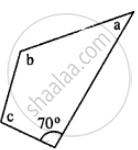Advertisements
Advertisements
प्रश्न
Two diagonals of an isosceles trapezium are x cm and (3x – 8) cm. Find the value of x.
उत्तर
∵ The diagonals of an isosceles trapezium are of equal length

∴ 3x – 8 = x
⇒ 3x – x = 8 cm
⇒ 2x = 8 cm
⇒ x = 4 cm
∴ The value of x is 4 cm
APPEARS IN
संबंधित प्रश्न
In a quadrilateral, define of the following Adjacent sides .
In a quadrilateral, define of the following Opposite sides .
In a quadrilateral, define of the following Opposite angles .
Complete of the following, so as to make a true statement:
A point is in the interior of a convex quadrilateral, if it is in the ..... of its two opposite angles.
Complete of the following, so as to make a true statement:
A quadrilateral is convex if, for each side, the remaining ______ lie on the same side of the line containing the side.
In Fig. 16.19, ABCD is a quadrilateral.
Name a pair of opposite angles.

In the given figure, PQRS is an isosceles trapezium. Find x and y.

In the given figure, ABCD is a trapezium. Find the values of x and y.

Complete the following statement by means of one of those given in brackets against each:
If in a quadrilateral only one pair of opposite sides are parallel, the quadrilateral is ................
In quadrilateral ABCD, side AB is parallel to side DC. If ∠A : ∠D = 1 : 2 and ∠C : ∠B = 4 : 5
(i) Calculate each angle of the quadrilateral.
(ii) Assign a special name to quadrilateral ABCD
In the given figure : ∠b = 2a + 15 and ∠c = 3a + 5; find the values of b and c.

In a trapezium ABCD, side AB is parallel to side DC. If ∠A = x° and ∠D = (3x – 20)°; find the value of x.
In parallelogram ABCD, ∠A = 90°
(i) What is the measure of angle B.
(ii) Write the special name of the parallelogram.
The diagonals of a rhombus are 6 .cm and 8 cm. State the angle at which these diagonals intersect.
Three angles of a quadrilateral are 75º, 90º and 75º. The fourth angle is ______.
What is the maximum number of obtuse angles that a quadrilateral can have?
A quadrilateral can have all four angles as obtuse.
If the sum of two angles is equal to an obtuse angle, then which of the following is not possible?
What conclusion can be drawn from part of given figure, if BD bisects ∠ABC?
